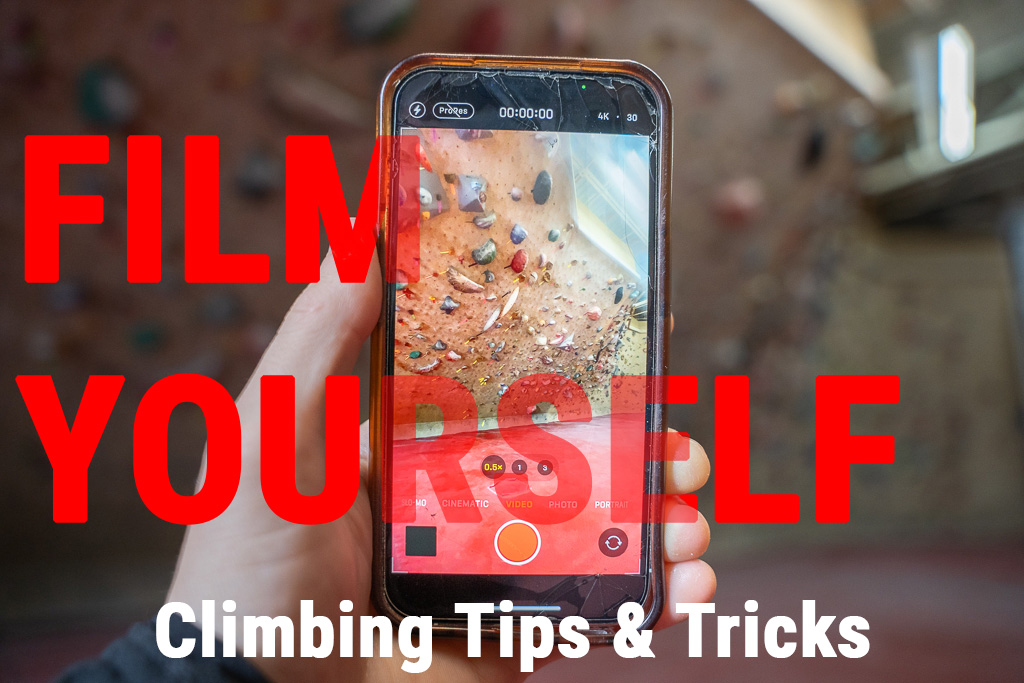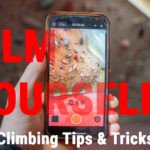Film Yourself Climbing! Climbing Tips & Tricks

Filming yourself isn’t just about posting your latest send to Instagram; it can help your climbing, too. When you climb and you fail or succeed, can you picture what you did? How did it feel? Did you climb well? Did you climb perfectly? How do you know? When you film yourself, you can immediately compare that “feeling” to direct evidence of how you climbed and what exactly you did on the wall.
How do we incorporate filming into our session? If you climb and have social media, there’s a good chance that in today’s oversaturated social media universe, you or someone you know have filmed themselves. Chances are also good that the only motivation behind that video was to look cool and show off your favorite activity. And that’s okay too! For this article, we are going to talk about incorporating filming as a training tool to improve performance. We’ve talked about the “feel” of climbing, but oftentimes the “feel” and how we actually performed don’t line up. So how can you use filming to improve? What I want you to do is, before watching your video, really give yourself an honest opinion of how you “felt” and how you think you performed. After you’ve done this, review the tape and see how your previous beliefs line up to what you are seeing.

What should you film? Film everything! Your warm-up, your project, your flash attempt, or that fun route you do for yourself. Filming isn’t just for your project; film climbs that are “easy”, that you warm up on and never fall. How effective is your movement? Are your arms straight? Look for the little things, things that might waste energy, or complicate simple movement. Improving and training starts easy; if we can’t move properly on easy routes, how are we going to move well on difficult routes? By lowering the difficulty, we can take the intensity out and focus on technique. But don’t just film easy routes. Pick a route to flash—it could be an easy or hard flash—but introduce a new variable: uncertainty. How well do you execute and move when you don’t know the moves and have the route dialed? How much wasted movement and energy is there? Review the tapes and then give the route a proper second or third try, actively trying to move better.
For projecting, filming yourself is a huge asset. When you are trying something that is at your absolute limit, it’s hard to focus and break down all the small details—a slight adjustment of the hips, a subtle flag, or energy being wasted with bent arms. When we film a project, we have direct evidence of what worked and didn’t work. We also have a visual collection of beta (good or bad); no need to write notes.
When we climb in a group and we are collectively working a route, we share information, offer critiques, and problem-solve together. When we climb alone, we don’t get that same raw, uninterrupted feedback loop. Filming can help provide a similar experience.
Filming tips and tricks!
Angles! Somewhere between directly behind and directly to the side of the climber is a sweet spot. I like to be able to see the holds, my arms & feet, and where my hips are in relation to the wall.
Get specific, you don’t always need to film the entire climb. If there’s a specific sequence, you can focus in. That way you don’t only have zoomed out videos where you can’t analyze yourself.
Tripods! Smart phones are great; they take amazing video, have wide angles, low light capabilities, and a zoomable screen for instant review. Unfortunately, they don’t balance well on their own. A little smart phone tripod lets you capture whatever angle you want and need!
Practice! “Film climb, watch climb” seems super simple. But the more you can analyze, pull information from the video, notice the small details, and act on those details. The more effective filming will be!
Climbing is dangerous, it involves inherent and other risks and cannot be eliminated. The information presented here does not describe all of the risks associated with climbing and is not intended to replace or supersede expert instruction and training.
© 2024 Vertical Endeavors, Inc. All rights reserved. The contents of this article, photographs, and graphical representations are protected by U.S. and International copyright laws. Reproduction and distribution, in part or whole, without written permission from Vertical Endeavors are prohibited. The opinions and information contained in this article are for entertainment and informative purposes. They are those of the author and may not represent those of Vertical Endeavors, and do not necessarily reflect the ideas, ideologies, opinions, or points of view of the organization, affiliates, owners, stockholders, partners, suppliers, licensors, or staff. Under no circumstances shall Vertical Endeavors or any entity that is, has been, or will be affiliated be liable for any indirect, incidental, consequential, special, or exemplary damages arising out of or in connection with the information contained in this article.

